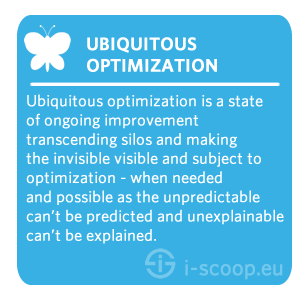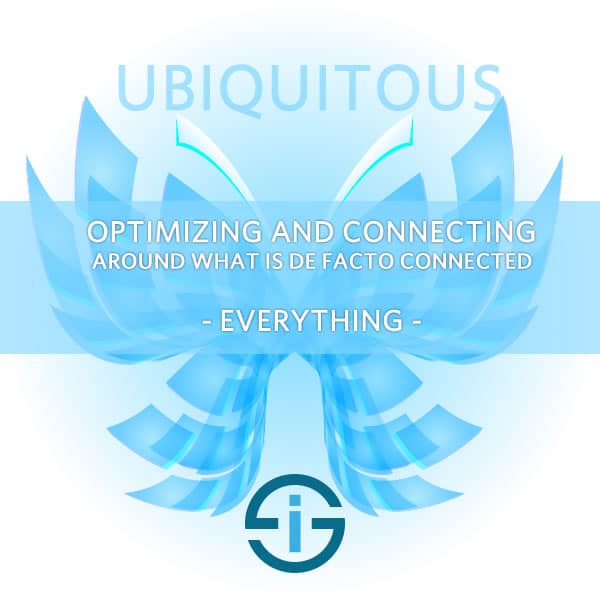 Everything is connected. It always has been, also beyond the currently “hot” context of technology. When everything is connected, in various degrees and ways, a small change can have a huge consequence, especially within so-called sensitive systems.
Everything is connected. It always has been, also beyond the currently “hot” context of technology. When everything is connected, in various degrees and ways, a small change can have a huge consequence, especially within so-called sensitive systems.
It’s the well-known butterfly effect. Originating from the field of meteorology, mathematics and (later) chaos theory, the butterfly effect quickly became popular in numerous other fields, ranging from philosophy and sociology to economics and business.
The multiple layers of connectedness in transformation
Today we live in a more connected society and business reality than ever before and “the sensitive dependence” – as we know it from the butterfly effect – within ecosystems of connected processes, business activities and human interactions is essential in transformative processes.
Digital transformation in fact is about 1) connecting what needs to be connected in a hyper connected age but also and maybe even more importantly 2) connecting what needed to be connected to begin with. Let’s say that ubiquitous optimization, just like transformation (as partially a reality of catching up) in the end is optimizing and connecting around what is – and often always has been – de facto connected: everything. Albeit with some areas of connectedness being more sensitive to the impact of small change and huge consequence. It’s in the degree of connectedness, sensitivity and impact that prioritization comes in.
This is not (just) about technology although it plays a role in both mentioned transformation drivers/goals. At the same time technology also in many areas is the “connector”. Yet, it’s – not that – funny to see how our fascination with “connecting technologies”, with the Internet of Things as probably the most often mentioned one, makes us focus on that aspect all too often.
The key element of transformation, optimization and “connectedness”, however, is not about all this. It’s about how everything we do, perceive, express, organize, start, stop, say and hear has an influence one way or the other.
For all too long organizations have overlooked this or simply weren’t able to 1) see the need to have a more connected view and/or 2) make it happen.
The cacophony of marketing optimization
 Let’s take a look at it from the “ubiquitous optimization” perspective by focusing on one specific area where businesses have always tried to optimize: (digital) marketing.
Let’s take a look at it from the “ubiquitous optimization” perspective by focusing on one specific area where businesses have always tried to optimize: (digital) marketing.
Even today such a seemingly easy operation (and it isn’t easy to implement in most organizations) happens in disconnected silos. A classic scenario: the email marketer (if all is well) optimizes the copy , calls-to-action and each single element aiming at optimizing the “success” of the email. The landing page expert optimizes the words, look and feel etc. to optimize conversions and/or facilitate the path of the customer. The search engine marketer optimizes for searchers and search engines. Depending on the type of conversion and the nature and format of the “conversion object”, others are involved, from copywriters and video producers to user experience experts etc.
Yet, de facto, disconnected systems and the siloed ways of working stand in the way of an “end-to-end” optimization within even a marketing campaign context. And we haven’t even brought that weird phenomenon, called the customer, nor the fact that in larger organizations many people do many – sometimes overlapping – campaigns with even less alignment. Indeed, even today in this big marketing optimization exercise we often look like an orchestra producing nothing more than a cacophony.
However, although these de facto disconnections are a fact, each part in the total equation can play a huge role. The button on a landing page, the images or words we use, the timing,… It’s one of the reasons why marketers keep having the dream of hyper-personalization. Even in an orchestra producing a cacophony the overall sound is defined by each member and instrument. And the real differentiator in the whole equation, the customer can have an even bigger impact by sometimes seemingly small actions.
Isn’t this what in the end digital disruption is partially about as well? When individuals ‘en masse’ display small changes in behaviour, leading to massive shifts in a total industry.

Connecting optimization across functions, divisions and de facto connectedness
Making abstraction of the crucial position of the customer – the employee, the buyer, the partner – the picture becomes even more complex when we add more layers. Look at marketing again and bring in sales. If the way both work together in so many areas isn’t optimized, marketing optimization loses its impact.
Let’s add again another layer: the customer experience. If marketing creates fabulous means for customer to interact and transact but the underlying back-office processes are not optimized and connected, the overall customer experience and business outcome fails.
The more layers we add and the more we see how everything needs to be optimized and fit together, the more we see how seemingly small changes can have huge effects and that’s the essence of one aspect of ubiquitous optimization: seeing how things work together beyond the traditional siloed ways.
Everything is connected even if it’s disconnected from a process and technology view. Connecting around that – and seeing how it is influenced by de facto connections – is the first step of optimization in the ubiquitous sense. Because in reality all “systems” are becoming sensitive as the differences and/or speed between small changes and huge consequences become smaller in many areas.
In a marketing context it’s unbreaking marketing that was broken as we fail(ed) to connect around customers. In a business context it’s closing the gaps and leaks between numerous processes and divisions, including functions we haven’t even considered connecting before.
Today we have no choice anymore as technology, business realities and the customer are more connected than ever. But that doesn’t mean we’ve connected technology and business processes to serve the hugely impactful customer – the butterfly – better.
The paradox of ubiquitous optimization and the butterfly effect
Optimization is a state of ongoing improvement transcending silos and making the invisible visible and subject to optimization. However, there is no such thing as an optimal state. The complexity and dynamic nature of business as a human given always contains a huge element of what cannot be predicted and thus not be prepared for nor reactively adjusted for.
This is the paradox of the butterfly effect or better of how we have started to understand it. When meteorologist Edward Lorenz, who coined the term butterfly effect, wrote his paper “Predictability: Does the Flap of a Butterfly’s Wings in Brazil Set Off a Tornado in Texas?” (PDF opens), his aim was not to point out how we can see and understand how everything is connected. On the contrary: how can we understand and predict everything if tiny changes that are unpredictable in sensitive systems go beyond our understanding and ability to catch reality and improve predictability.
The world is highly unpredictable as are economies, markets, businesses and people – the drivers of it all. Yet, the more connections we see – and connect the better we can strive towards a holistic framework of optimization, then breaking it up for prioritized optimization again while keeping an eye on the connected layers we previously overlooked and adding new layers as their role becomes visible.
Top image purchased under license from Shutterstock

